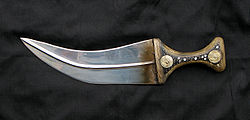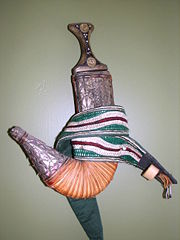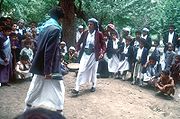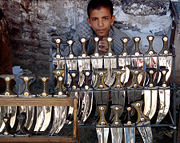
Jambiya
Encyclopedia

Dagger
A dagger is a fighting knife with a sharp point designed or capable of being used as a thrusting or stabbing weapon. The design dates to human prehistory, and daggers have been used throughout human experience to the modern day in close combat confrontations...
, but it is generally used to describe a specific type of dagger with a short curved blade that is worn on a belt. Although the term jambiya is also used in other Arab countries, it is mostly associated with people of Yemen
Yemen
The Republic of Yemen , commonly known as Yemen , is a country located in the Middle East, occupying the southwestern to southern end of the Arabian Peninsula. It is bordered by Saudi Arabia to the north, the Red Sea to the west, and Oman to the east....
. Men typically above the age of 14 wear it as an accessory to their clothing.
Types of janbiya

Yemeni rial
The rial or riyal is the currency of Yemen. It is technically divided into 100 fils, although coins denominated in fils have not been issued since Yemeni unification.-History:...
s to 200 million Yemeni Rials. The brand of a janbiya is associated with the material with which it is made as well as its quality and design.
The hilt or handle
The most significant part of a janbiya is its hiltHilt
The hilt of a sword is its handle, consisting of a guard,grip and pommel. The guard may contain a crossguard or quillons. A ricasso may also be present, but this is rarely the case...
. In fact, the price of a janbiya is in most cases determined by its hilt. The saifani handle is known to be the most famous and is found on the daggers of higher class citizens. The saifani handle is made of rhinoceros' horns, which can cost up to $1500 USD per kilogram. Different versions of saifani handles can be distinguished by their colour. Most other janbiya handles are made of different types of horns or wood. Apart from the material used for the handle, the design and detail on the handle describe its value and the status of its owner.
The blade, sheath and belt
In the majority of cases the double-sided bladeBlade
A blade is that portion of a tool, weapon, or machine with a cutting edge and/or a pointed tip that is designed to cut and/or puncture, stab, slash, chop, slice, thrust, or scrape animate or inanimate surfaces or materials...
of the janbiya is constructed of steel. The blade is stored in a sheath
Sheath
Sheath may refer to:* Scabbard, a sheath for holding a sword, knife, or other large blade, as well as guns, such as rifles.* The outer covering of a cable* Condom, a kind of contraception* Debye sheath, a layer of a plasma in physics...
, usually made of wood. The sheath is commonly decorated with various ornaments that signify status. These include silver work, semi-precious stones and leather. The sheath is fixed on a leather belt which is normally 2-3 inches wide. The belt is usually worn around the lower abdomen. There are often other items attached to this belt, such as a silver purse for containing money and change.
Use of the janbiya
Despite the significance of the janbiya, it is still a weapon. Although people have used it in times of dispute, there are societal norms that must be followed in order to avoid defamation. The janbiya should only come out of its sheath in extreme cases of conflict. It is also commonly used in traditional events such as dances.The Yemeni jambia


Dagger
A dagger is a fighting knife with a sharp point designed or capable of being used as a thrusting or stabbing weapon. The design dates to human prehistory, and daggers have been used throughout human experience to the modern day in close combat confrontations...
worn by men in Yemen
Yemen
The Republic of Yemen , commonly known as Yemen , is a country located in the Middle East, occupying the southwestern to southern end of the Arabian Peninsula. It is bordered by Saudi Arabia to the north, the Red Sea to the west, and Oman to the east....
. The handle of a janbiya tells the status of the man who wears it.
Structure and make
Janbias are constituted of a handle, a blade, and a sheath in which the blade is held. It is made of a certain sort of wood, to hold the blade that is fixed to the waist from underneath with an upward curved sheath. The belt that holds the janbia is made of tanned leather, or some thick cloth. There are specialized markets and handicraft markets that decorate it with golden wires.The janbia handle often tells of the social status of the man who wears it. Janbias are made of African rhinoceros horn, ivory and also Almoswae horn. A kilo of this often costs $1500. The manufacturers receive this through smugglers, due to the international ban on the substance. This contributed to the retreat in the manufacturing of valuable Janbias. The rhinoceros horn is considered to be the most precious. The Janbias value increases as it acquires modern and old qualities.
Qualities of janbia in Yemen
The most famous sort of the janbia is that which has a “saifani” handle. It has a dim yellowish luster. When it is clearer, it turns into a yellow color. This is called saifani heart.Some of the saifani handles are called “asadi”, when they turn into greenish yellow. When the handle becomes whitish yellow, it is called Zaraf. There is also an albasali (onionish), kind whose color looks like that of a white onion.
The saifani janbia is often worn by dignitary persons; among them are the Hashimites (an Arab tribe which claims a direct bloodline to the prophet Muhammad
Muhammad
Muhammad |ligature]] at U+FDF4 ;Arabic pronunciation varies regionally; the first vowel ranges from ~~; the second and the last vowel: ~~~. There are dialects which have no stress. In Egypt, it is pronounced not in religious contexts...
), the judges, famous merchants and businessmen. Some of these Janbias cost about Yr 70 millions, like that of sheikh Al-Shaif, which goes back to Imam Yahia Hameed Aldeen. The ordinary janbias cost about Yr 10 - 50 thousands.
Sources
- Friedman, David and Cook, Elizabeth. 1988, 1990, 1992.

